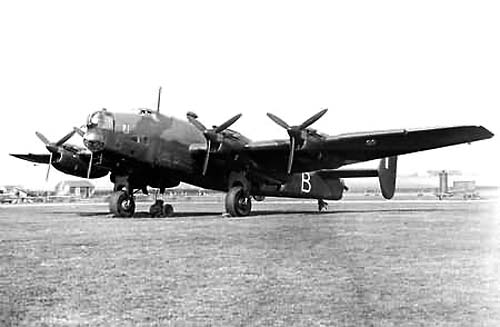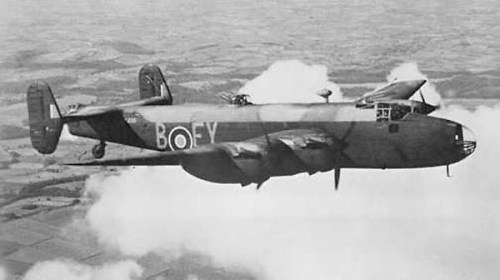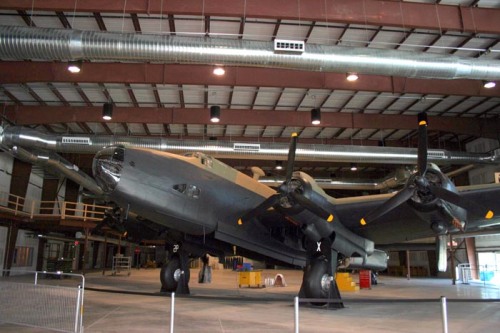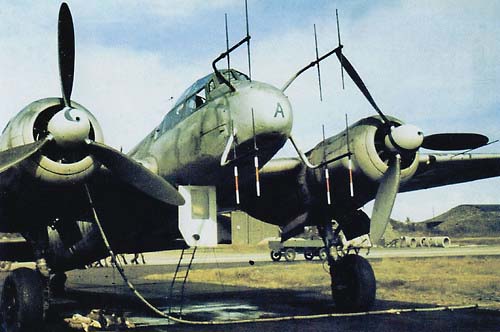According to Roy Irons in his splendid book, “The Relentless Offensive: War and Bomber Command”, Arthur Harris hated the Short Stirling, but he reserved his finest vitriol for the Handley Page Halifax. Here’s a Mark I:
The Mark I had Merlins and a front turret but the Mark 2 had the Merlins and a different nose:
The Mark III has the familiar nose, but has a different tail and Bristol Hercules radial engines:
Harris was not alone though in his hostility towards the Halifax. It was well known fact that the Halifax could not lift its bombload up to 20,000 feet and that its range was too short to take any 0f the longer, more evasive routes as the Lancasters did. Per hundred tons of bombs dropped, the Lancaster lost only one third of the personnel who were killed in Halifaxes. Overall, three Halifaxes were lost to every two Lancasters and those two Lancasters dropped almost twice the weight of bombs dropped by the three Halifaxes.
Harris knew all of these basic facts about the Halifax but he also knew a great deal of other information which nobody else was given. Most of it came from the captured pilots of Junkers Ju88 nightfighters. They reported that they “could normally approach our aircraft well within gun range and even up to fifty yards without apparently being seen at all”.
Here’s a Ju88 night fighter:
To prove the point, Harris borrowed a Bristol Beaufighter and its crew from 25 Squadron at RAF Wittering and had a Halifax bomber put to the test. The two crewmembers in the Beaufighter found that the Halifax bomber they were chasing had “inadequate exhaust dampers” which meant that the flames from the bomber’s engines were visible to the Beaufighter one and a half miles away. In contrast, the rear gunner of the Halifax could only see the Beaufighter if it was within 1100 yards, just over six tenths of a mile. And that was looking back in level flight. Harris found that the Halifax rear turret possessed “blindness in all directions, and especially downwards”. He stated that the turret was “80% angle iron and 20% scratched perspex”.
Only in 1944 did a turret which has the kind of visibility that is required become available. It was actually designed by Bomber Command themselves. This was the Rose turret, mentioned previously, which was designed, at the specific demands of Bomber Harris, by Air Vice Marshal Edward Rice. Rice was one of the senior Bomber Command station commanders, and had travelled with Harris to visit Rose Brothers at the start of the project. He subsequently led No. 1 Group RAF. Here’s a Rose turret being fitted. Bigger, longer guns and no metal in the line of vision:
Harris called the Halifax “a deplorable aircraft” on more than one occasion. He thought that the aircraft and its dreadful Bristol Hercules engines were particularly well suited to each other and that these awful engines should be reserved exclusively for the Halifax, because “it’s useless anyway”. Harris despaired that:
“nothing whatever is being done to make this deplorable product worthy for war”.
Harris was no fool, though, and realised that:
“the two strongest motives of Englishmen in the aircraft industry are patriotic devotion and commercial gain. They will never think of new designs when more orders for the old ones are to be had. To obtain or maintain an order book, aircraft companies will promise anything”.
Occasionally, Harris put it more bluntly:
“Nothing will be done until Handley Page and his gang are kicked out, lock, stock and barrel.”
This could not be done though, and instead Handley Page continued to make Halifaxes and to sell them to the RAF, whose use of “this deplorable aircraft” was limited to attacking short range targets. The reason for this was that if the Halifax was abandoned, six months’ bomber production would have been lost, because all of the extra tools and facilities for producing Lancasters would have needed to be put into place.
Harris was convinced that the Bomber Command offensive was vital to winning the war. He had no patience whatsoever with any of the board members at either Handley Page or Shorts:
“Unless we can get the heavy bomber programme put right, we are sunk. We cannot do this by polite negotiation with these crooks and incompetents. In Russia it would long ago have been arranged with a gun, and to that extent, I am a fervid Communist.”
Just to make it 100% clear, the “crooks and incompetents” were Handley Page and his gang and Oswald Short and a good many others in his firm. And Harris wanted them all put against a wall and shot:










A bit drastic
Not in Bomber Harris’ world! To be honest, he must have felt rather isolated in his desire to wage the bombing war and to win it. Civil servants who should all have a cap badge with the motto “No-can-do” on it. Aircraft companies which had not produced a decent design in a considerable number of years. Fairey, Miles, Handley Page and Shorts (except for the Sunderland) .
I suppose it was frustration on his part, coupled with his background in Southern Rhodesia, where if there was a problem, you solved it yourself.
I’m sure
Well – that solution ended one problem, eh?
off topic – I understand your Imperial War Museum will finally be reopening.
It certainly did!
The government has allowed museums and art galleries to open recently, subject to the advisability of wearing a mask, and social distancing. I don’t think it should be a problem to be honest……unlike pubs and restaurants where 70-80% of people asked thought they were taking a very large risk.
Exactly my feelings.
Was his critic towards the Halifax Mark III also? So many RCAF bomber squadrons flew the Halifax and have seemed to like it.
As far as I know, Harris lumped together all the different marks of the Halifax in his criticism. I am aware that a lot of the men who used the Halifax were very happy with it, but I have always imagined that it was because they hadn’t ever flown the Lancaster.
That may even have been a definite policy, namely to limit the use of the Halifax to a number of squadrons who would not be receiving any Lancasters in the foreseeable future.
It would be certainly be very interesting to hear the opinions of men who had flown both types. Did they agree with Harris.or did they think he was mistaken?
425 Alouette squadron converted to Lancasters in May 1945 so they never used it during the war. Reading what you wrote I believe Harris was right. I would not want to argue with him. Your explanation about the German pilots closing in and the test with a Beaufighter are proof enough.
It certainly is. The one thing about Harris is that, no matter how many casualties there were, his men, “The Old Lags”, were 100% behind him and they held him in very high regard. They knew that, just like them, he wanted to bomb the Germans and win the war.
Yesterday I reblogged the five parts on my main RCAF 425 Alouette blog.
Thank you so much for that. I find Harris a remarkable character who must have been like an earthquake in the quiet world of the British civil service and the senior ranks of the RAF. My Dad saw him visit Elsham Wolds and he described him to me as “a right Tartar”. But in a war-winning kind of way, of course.
It seems I’ve read that the later Halifax models did sort out most of the type’s problems? But the Lancaster was overall a more solid design regardless.
Ultimately I think Harris spent too much energy being unhappy and not enough making the best of what he had. Obviously that “grumpiness” serves a function when comes to making things happen, but it can be counter-productive too.
I’ve just been reading a lot about the South Pacific air war and the rivalry between P-38 and P-47 pilots. It got extreme to the point where if you only listened to one side you could be convinced the other plane was the worst hunk of junk in history. Even though both planes ultimately had similar kill ratios and survivability. It just makes me wonder how much of his attitude was reasonable. Especially since he was not always the most reasonable of men!
The problem with Harris was that in the early years of the war he was faced with a wall of self satisfied people who were happy with a very low level of achievement. Harris, with his background in Africa of solving problems quickly and of using his own initiative, was not willing to wait months or even years to see a problem solved.
That must have caused him a great deal of frustration and he was certainly totally incapable of making the best of what he had. The war that he was responsible for winning quite simply could not have been won with the Battle, the Blenheim, the Manchester, the Hampden, the Stirling and the other types that that “a wall of self satisfied people” had been happy to put into squadron service.
Personally, I think that Churchill realised that the status quo needed a good shake-up and that a “foreigner” was the best person to get things done. That was why he appointed a Canadian as the World War II Minister of Aircraft Production. He understood how complacent and smug the current people at the top were.
Certainly the situation at Bomber Command was bad when Harris took over. Although the Wellington measures up as well as any aircraft of its era, but clearly things needed to change to win the War. I think it was in Max Hastings’ book Bomber Command he mentions that many nights the Germans were unsure what CITY they had even been trying to hit; obviously an unacceptable status!
Absolutely! And quite often the radio would announce that “last night our aircraft bombed Essen” but it would be news to the people of Essen!
They did improve though. I remember an RAF veteran trying to get a job in 1946. The clerk behind the counter asked him what particular skills he had. The ex-pilot replied “Well, with the the right equipment and the right back-up, I can destroy a medium sized town in 19 minutes”.
Unfortunately, that was not a skill required to work in a shoe shop.
I’m sad to hear that Short produced such poor Bombers because I have always had a soft spot for the Short Sunderland that I assume was built by the same people.
It was. The Sunderland was a design from the mid 1930s and Short’s unsuccessful bomber, the Stirling, was based on it.
According to Wikipedia “They created the Stirling by removing the lower deck and boat hull of the S.25 Sunderland. The new design was largely identical to the Sunderland: the wings and controls were the same, construction was identical and it even retained the slight upward bend at the rear of the fuselage, which had originally been intended to keep the Sunderland’s tail clear of sea spray.”
I’m not a designer, but that does seem a rather lazy way of developing a new bomber!
The comment section is so much interesting to read. I did not know the Stirling was a sort of chopped-off Sunderland.
Neither did I, although I knew that the Sunderland was closely connected to the Stirling. We never stop learning!
A very interesting account John. The Halifax certainly lacked the many good qualities of the Lancaster and from what I’ve read it was generally liked by crews. But if you’ve never driven a Rolls Royce you can never appreciate the better quality. The British aircraft industry was full of ‘dead wood’ and the drive to improve lasted well beyond the Second World War. I recently read two books ‘Empire of the clouds’ and ‘The quick and the dead’, both of which tell the tale of the demise of Britain’s post war aircraft industry. They cite pretty much what you have, the eventual consequences of this lack of drive being very obvious.
“Lack of drive” captures it perfectly. I seem to remember vaguely how in ‘Empire of the Clouds’ everything stopped for lunch, even if they were in the middle of something. And a couple of hours later, of course “Everything stops for tea”.
We were the nation who produced a powerful and reliable jet engine by the end of the war and had been the first to split the atom. Both of those we just, literally, gave away to the Americans and the Soviets. We did all the preliminary work on jet airliners, only to see the competition produce the Boeing 707 which had none of the faults of the Comet. And as for the Concorde. Well, let me just say how both the Americans and the Soviets tried to imitate this incredible aircraft but seemingly, couldn’t manage it. Yet still that beautiful airliner didn’t achieve anything even close to what it should have done.
“Lack of drive”, the national motto that took over from Harris’ motto for the Civil Service of “No-can-do”.
I whole heartedly agree John.
British aviation was always a motley collection of under-resourced cottage industries. Sometimes they got it superbly right but they also produced a large number of flying turkeys.
The P51 Mustang was built to a UK specification but would it have been the same plane if manufacturing had been left to UK industry? The RR Merlin transformed its performance but it was Packard who could churn them out at a far higher quality than RR itself. We even found the production of blister canopies problematical.
At a time when the Bomber Offensive was the Schwerpunkt of Britain’s war effort, the nearly three years it took to initiate, design, manufacture (and then only 400) up-gunned but unreliable Rose turrets must have sent Harris into apoplexy and speaks volumes about Britain’s fundamental manufacturing weakness and the doziness of the civil servants responsible.
Maybe Harris should have ordered his crews to drop a few sticks on Whitehall to clear-out the deadwood in the Air Ministry/Ministry of Supply.
You have hit the nail right on the head. It was the Ministry of Supply which was Harris’ chief bugbear. He always said things such as they were fighting a war but he didn’t know who it was against, he would have had them all shot and so on.
And all of this, of course, comes as a legacy of the class system and the nepotism that seems to rule our society even now.
It’s a pity that we can’t have Harris back as head of the BBC. He’d sort out their policy of jobs for the boys (and girls).
Oh my but Harris’ passion IMO went a little overboard, if you ask me. Passion comes in all sizes I suppose.
Yes, I think he might have been a little difficult to work with, even for the people who were on his side ! Most of what he complained about, though, was justifiable.
The problem was that the civil servants had got their jobs because of who they were related to and so on. That promotes laziness which is something you cannot tolerate in times of war.
Ultimately, all he wanted to do was to win the war as quickly as possible, which was a good thing for everybody, even for the Germans he was fighting at the time.
Fascinating. I wonder how the Lancaster compares with the Liberator and Flying Fortress and so on.
The Liberator and Flying Fortress both had very large crews so you might lose ten or a dozen men at once if one was shot down. Having said that, the Lancaster was much more difficult to get out of, and an average of only 1-2 of the seven would survive. The Flying Fortress carried around 5,000lbs of bombs and 3,500lb to Berlin.The Liberator carried around 4,000, (I googled those figures and most sites say similar totals). A Mosquito could carry 4,000lbs to Berlin and a Lancaster’s bombload was usually 14,000 lbs and occasionally 20,000lbs.
The Americans bombed in daylight which must have taken incredible courage given the losses they had on some raids. The Lancaster bombed usually at night, but they still had losses at roughly the same levels as the Americans.
Overall, for me, the Lancaster was the best aircraft but one thing is for sure. Neither the RAF nor the Eighth Air Force had the monopoly on sheer courage. Nor the RAAF or the RCAF, come to that.
You might find this website interesting:
http://ww2podcast.com/news/the-de-havilland-mosquito-and-the-heavy-bombers/
John, if you want an idiosyncratic “colonial” to look into there is one, whose career was intimately bound up with Nottingham. The flamboyantly monikered Captain Athelstan Popkess: chief of the City Police. From his slightly controversial appointment in the early 1930s (he had been a Cadet Officer in Ireland during the Black & Tan era) to his very controversial sacking in 1959 (one that still affects policing today). Originally from South Africa, during his tenure Popkess was responsible for so many policing firsts the city’s force was widely considered the best, and at least ten years in advance of any other, in Britain.
At a time when the Met’ liked to think of itself in terms of “The Blue Lamp” (George Dixon, RIP), Nottingham’s finest were taking an altogether more technological approach towards preventing crime.
https://www.britishpathe.com/video/new-police-alarm-to-fight-theft-wave/query/Nottingham+City+police
Thanks very much for that. It’s an absolutely wonderful video, and thankfully, of a very high quality. I had a friend with Derbyshire Police years ago, and he told me that in those days, 90% + of the crimes solved were thanks to paid informants, but technology now plays such a huge role.
It certainly looks as if Nottingham and Captain Popkess’ use of the technology of his day may have been one of the first steps on that long road to modern policing.
Popkess did have a connexion with the NHS. He was very keen on sport and was instrumental in the purchase of the school’s old playing field on Mansfield Road.
His real passion was cricket. Nottingham City Police was noted for having very tall officers but if Popkess saw a recruit who might strengthen the force’s XI then the tape measure could be put aside.
His most notable “pot hunting” recruit was a certain Reg Simpson (ON). Simpson had established a stellar reputation as a batsman in the local leagues and fresh out of the Vth Form he signed up with Nottingham City Police.
For the nice middle-class boy, there was no time pounding the beat or “encouraging” drunks out of Yates’s at kicking-out time. He started as an aide; moved on to the force’s Special Branch and joined the RAF in 1940.
Oh, and he played for England/MCC 27 times and was a Wisden Cricketer of the Year in 1950. Probably the High School’s finest sportsman.
Thanks a lot for that. It was very interesting. When Reg Simpson came to the High School in 1931 the family lived over the grocer’s shop at 40 Foxhall Road on the corner with Berridge Road East, just to the west of Sherwood Rise. I don’t know how middle class that would have made him. Perhaps the area was nicer back then.
A few years back, I had a friend who moved into a terraced house in nearby Leslie Road and he found out the hard way not to leave his washing out to dry in his back yard. When he got back from the shops, it had all been stolen.
Heello mate great blog post
I’m glad you enjoyed it!